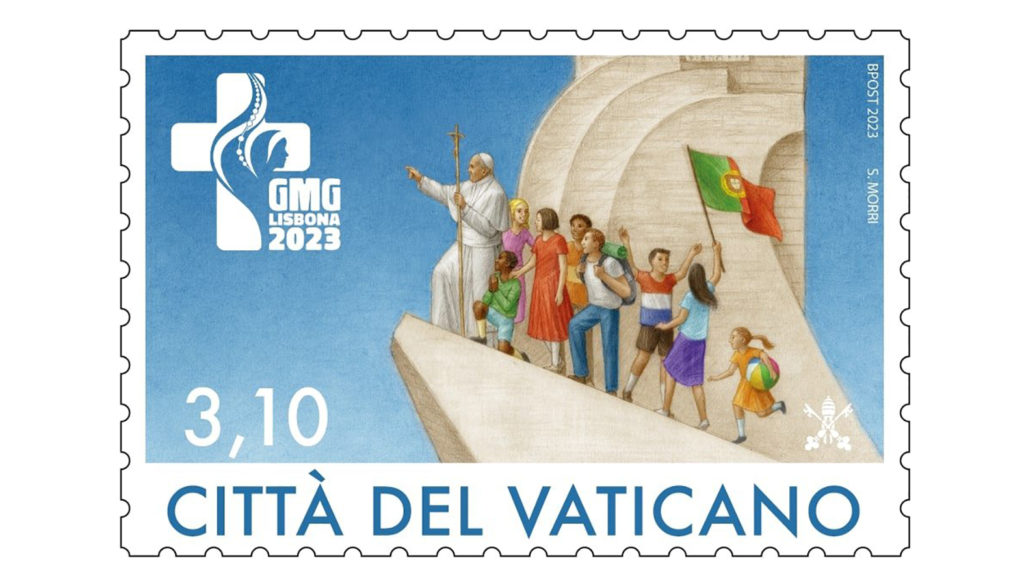One of the hard lessons about being pope is that while it can require massive effort to accomplish something positive, it doesn’t take much at all to get you into trouble. As proof of the point, Pope Francis is facing blowback right now over a tiny piece of paper that measures less than two inches by 1.3 inches.
The paper in question is a new Vatican postage stamp promoting the next World Youth Day, to be staged in Lisbon, Portugal, August 1-6.
The stamp depicts Francis leading a small coterie of youth in pointing toward the horizon and, therefore, toward the future. It’s inspired by a famous statue in Lisbon called the Padrão dos Descobrimentos, or the “Monument of the Discoveries,” which was erected in 1960 to mark the 500th anniversary of the death of Prince Henry the Navigator, and thus to celebrate Portugal’s Age of Discovery.
The choice has generated objections, both in Portugal and elsewhere, among critics who see it as celebrating colonial exploitation and oppression, finding it especially ironic that the Vatican would embrace such imagery just weeks after formally disowning the colonial-era “doctrine of discovery.”
It doesn’t help that the statue in Lisbon was erected under the dictatorship of António de Oliveira Salazar, with several observers on social media pointing out that the Vatican stamp bears comparison to imagery employed by Portugal’s “Secretariat of National Propaganda” during Salazar’s Estado Novo, or “New State.”
Even one of the pontiff’s own officials, Portuguese Bishop Carlos Alberto de Pinho Moreira Azevedo, delegate to the Pontifical Council for Social Sciences, declared that he found the stamp to be in “poor taste.”
“Certainly, Pope Francis does not identify with this nationalist image,” Azevedo told a Portuguese new outlet, “[which] contradicts universal fraternity.”
The controversy over the stamp comes at a time when Portuguese society is engaged in an examination of conscience regarding its colonial legacy, with President Marcelo Rebelo suggesting in late April that Portugal should apologize for past abuses in a conversation with Brazilian President Luiz Inácio Lula da Silva.
It marked the first time a southern European leader has suggested a national apology for the colonial period.
As of yesterday, several Portuguese media outlets were reporting that the stamp had been withdrawn, as it was no longer available for sale in the Vatican post office on St. Peter’s Square. With an initial run of 45,000 copies, the stamp was issued Tuesday with a face value of 3.10 Euro.
In the presentation of the stamp by the Vatican’s Dicastery for Family, Laity and Life, the department which oversees World Youth Day, there was no reference to the complicated history of the statue which inspired it.
“Just as in the monument Prince Henry the Navigator guides the crew to the discovery of the new world, on the stamp, Pope Francis guides the youth and the Church, represented by Peter’s boat, to the discovery of ‘this epochal change,’ as the Holy Father stated at the Ecclesial Convention in Florence, without quietly giving in to the habit of sailing by sight, to the point of removing the very reality of the port that awaits them,” a statement from the dicastery said.
Rosa Pedroso Lima, a spokesperson for the World Youth Day Foundation in Lisbon, stressed that “Pope Francis is committed to respect, breaking down walls, expanding borders, communicating with peoples, cultures and religions,” calling any other interpretation of the stamp “abusive” with regard to the pope’s intentions.
Though the Vatican has not officially confirmed Pope Francis’s participation in the World Youth Day gathering, the pontiff released a video message May 4 in which he told young people preparing for the event, “I’ll see you in Lisbon.”

